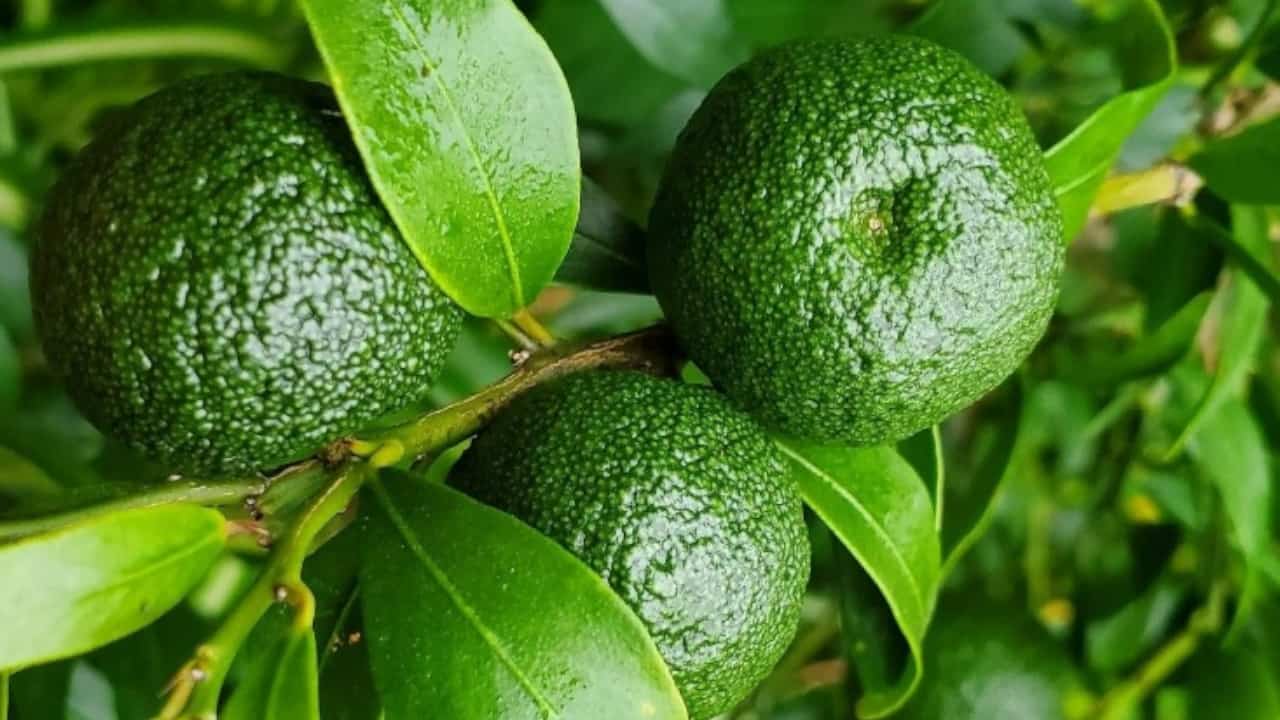Dooja
Citrus australis
Only available in Queensland
Dooja (also known as Qld Round Lime, Australian Round Lime or Gympie Lime) is a well-known Australian native lime with round green fruits. Researchers from The University of Queensland are studying the Dooja and other native species for their natural resistance to devastating horticultural diseases. Dooja limes are native to lowland forest ecosystems northwards of Beenleigh in Bundjalung country, subtropical Queensland.
Pinkish-white Spring flowers give way to green spherical, knobbly skinned fruits that reach about 6cm in diameter, and ripen to greenish-yellow from December to March. The fruit flesh isn’t especially juicy, but has a lovely crisp and sticky texture. Taste comes with a distinct, sour but slightly sweet flavour. The (relatively) thick oily rind is excellent for making zest, flavouring pastes, candied peel, and marmalade.
The branches of younger Dooja branches are covered with many needle-like thorns, so take care when harvesting! For best results, harvest only ripe fruits — these will come away easily from the tree when gently pulled.
The drought-tolerant Dooja does best in rich, loamy, well-drained soil under full sun, with plenty of water throughout the warmer months. For more prolific fruiting, fertilise lightly every 3 months with citrus fertiliser, and feed regularly with small quantities of worm castings or seaweed emulsion. This plant will tolerate light frosts.
Dooja grows slightly smaller and slower than other native limes, reaching up to 5m in garden conditions, but may be kept as small as 3m. Suitable for pots, it makes an excellent patio plant, garden ornament, or hedge if you don’t mind the thorns.
Aboriginal name(s):
- Dooja
The new leaves on my Dooja round lime tree are curled up and covered with wavy white lines. What should I do?
This is caused by an insect called a Citrus Leaf Miner. Remove the affected foliage and spray new leaves with horticultural oil.
What are the dark brown and black spots on my Finger Lime fruit and leaves?
Dooja round limes are susceptible to melanose, a fungus that affects all varieties of Citrus plants. The fungal spores develop in dead wood and are released by water or rainfall. Prune off all dead twigs and branches, and remove detritus from around the base of the tree. Avoid applying chemical sprays while your tree is in flower.
Why is my Dooja round lime not producing flowers or fruit?
Your plant may not be getting enough sunlight in its current spot; try shifting it to a sunnier position or moving shade objects to allow more light through. If you fertilise your soil, switch to a fertiliser with a lower nitrogen (N) percentage.
How much should I water my Dooja round lime?
Despite Dooja being a subtropical rainforest native, it’s still susceptible to over-watering as well as underwatering. Avoid planting this tree in heavy clay-based soils, opting instead for a rich loamy soil where water can drain freely. Mulch around the base of the trunk at the start of summer and water generously, easing off as the cooler and months set in. If you live in one of the wetter areas of Australia, you may get away with not watering your Round Lime at all during the winter/wet season.

Suitable for full-sun

Suitable for pots

Dimensions:
Height 4-7m
Width 3-5m

Tolerates drought

Tolerates sandy soils

Fruits from:
Year 1 onwards

Bird attracting

Attracts bees & insects

Suitable for hedging/screening

